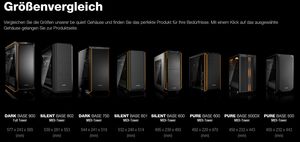Case FAQ: What you should know about PC cases (Update 2021)
Source: Hardware Luxx added 29th Dec 2020Page 1: Case FAQ: What you should know about PC cases (Update 2021)
In cooperation with be quiet!
The housing is available when a new PCs are usually way down the list. It is one of the most durable components and therefore deserves a certain amount of attention. However, there are some pitfalls when choosing a suitable case. Our FAQ is intended to draw attention to this and make it easier to buy a housing.
At the beginning there is the question of what kind of housing is actually needed. Because PC cases are available in a wide variety of sizes, at very different prices and with very different features. Especially with high-performance PCs, it is important which cooling options the housing offers. The case also plays an important role in the volume of the system. A well-chosen case can be a loyal companion for years to come. And it is precisely the modern, often highly modular housings that offer a lot of scope for adjustments – also to meet future trends.
What housing formats and materials are there?
The size of the case depends mainly on the desired mainboard and the available space. In addition, care should be taken to ensure that other components such as processor cooler, graphics card and power supply have enough space. Corresponding information is provided on the manufacturer’s product pages and the item descriptions in most online shops. The desired cooling solution can also have an effect on the size of the housing – especially if powerful water cooling is to be installed.
Most cases are tower cases, so they protrude upwards. If the width, depth and height are approximately the same, it is called a cube. This format is mainly used for smaller housings. The classic, flat desktop case of earlier times, however, has become rare.
Tower housings are roughly divided into mini towers, midi towers and full or big towers. However, some of the terms are not entirely clear. It is important that the desired mainboard fits into the appropriate housing. The mainboard formats supported are therefore always specified in the specifications of the housing.
The most typical mainboard formats are Mini-ITX (17 × 17 cm, usually one expansion card slot) , Micro-ATX or µATX (17, 4 × 24, 4 cm, mostly four expansion card slots), ATX (30, 5 × 24, 4 cm, usually seven expansion card slots) and E-ATX (30, 5 × 33 cm, usually seven expansion card slots). Because not all E-ATX mainboards reach the full E-ATX width by a long way, cases with E-ATX support are also advertised that are not actually intended for mainboards with the maximum E-ATX width. The manufacturers then usually specify the maximum exact dimensions the E-ATX mainboard may have. Typical is something like “E-ATX (Support 12 “x 11 “)”. Because the conversion factor from inches to centimeters is 2, 54, in this case an E-ATX mainboard with a height of 28, 5 cm and a width of 28 cm .
A concrete example of a typical midi tower that accepts E-ATX mainboards in addition to ATX mainboards is the be quiet! Silent Base 802. It is used for E-ATX mainboards up to 28, 5 x 27, 5 cm released. We mainly use this be quiet! Model as an example housing in this FAQ. A really full-grown full tower, however, is the be quiet! Top model Dark Base Pro 900 Rev. 2. If you are unsure how big the individual be quiet! Housings are in comparison, you can use the size comparison on the manufacturer’s website. Wikipedia has a much more detailed overview of the different mainboard form factors.
Currently, for PC Housing mainly used four different materials. Most cases have a robust steel frame. In particular, more elaborately shaped elements are made of plastic. The light metal aluminum can be used as a high-quality alternative to plastic and steel. Pure aluminum housings not only look particularly high-quality, they are also lighter than steel housings. However, because they are also significantly more expensive, manufacturers sometimes make a compromise: They manufacture the basic frame inexpensively from robust steel, but upgrade the outside of the housing with aluminum panels. In recent years, glass has finally established itself as a typical housing material. Glass side parts, but also some glass fronts and glass lids, allow glimpses into the interior. This means that the built-in hardware comes into its own even when the housing is closed.
In cooperation with be quiet!
< > Case FAQ: What you should know about PC cases ( Update 2021)
What is installed where?
